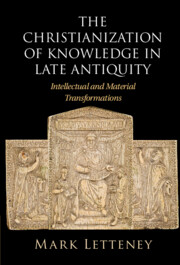Book contents
- The Christianization of Knowledge in Late Antiquity
- Reviews
- The Christianization of Knowledge in Late Antiquity
- Copyright page
- Dedication
- Contents
- Figures
- Acknowledgments
- Abbreviations
- 1 Christianizing Knowledge, or a Beginning of Late Antiquity
- Part I New Readers
- Part II New Texts
- Case Study: The Theodosian Code in Its Christian Conceptual Frame
- Bibliography
- Index
- References
Bibliography
Published online by Cambridge University Press: 28 September 2023
- The Christianization of Knowledge in Late Antiquity
- Reviews
- The Christianization of Knowledge in Late Antiquity
- Copyright page
- Dedication
- Contents
- Figures
- Acknowledgments
- Abbreviations
- 1 Christianizing Knowledge, or a Beginning of Late Antiquity
- Part I New Readers
- Part II New Texts
- Case Study: The Theodosian Code in Its Christian Conceptual Frame
- Bibliography
- Index
- References
Summary
- Type
- Chapter
- Information
- The Christianization of Knowledge in Late AntiquityIntellectual and Material Transformations, pp. 263 - 284Publisher: Cambridge University PressPrint publication year: 2023
- Creative Commons
- This content is Open Access and distributed under the terms of the Creative Commons Attribution licence CC-BY-NC 4.0 https://creativecommons.org/cclicenses/



